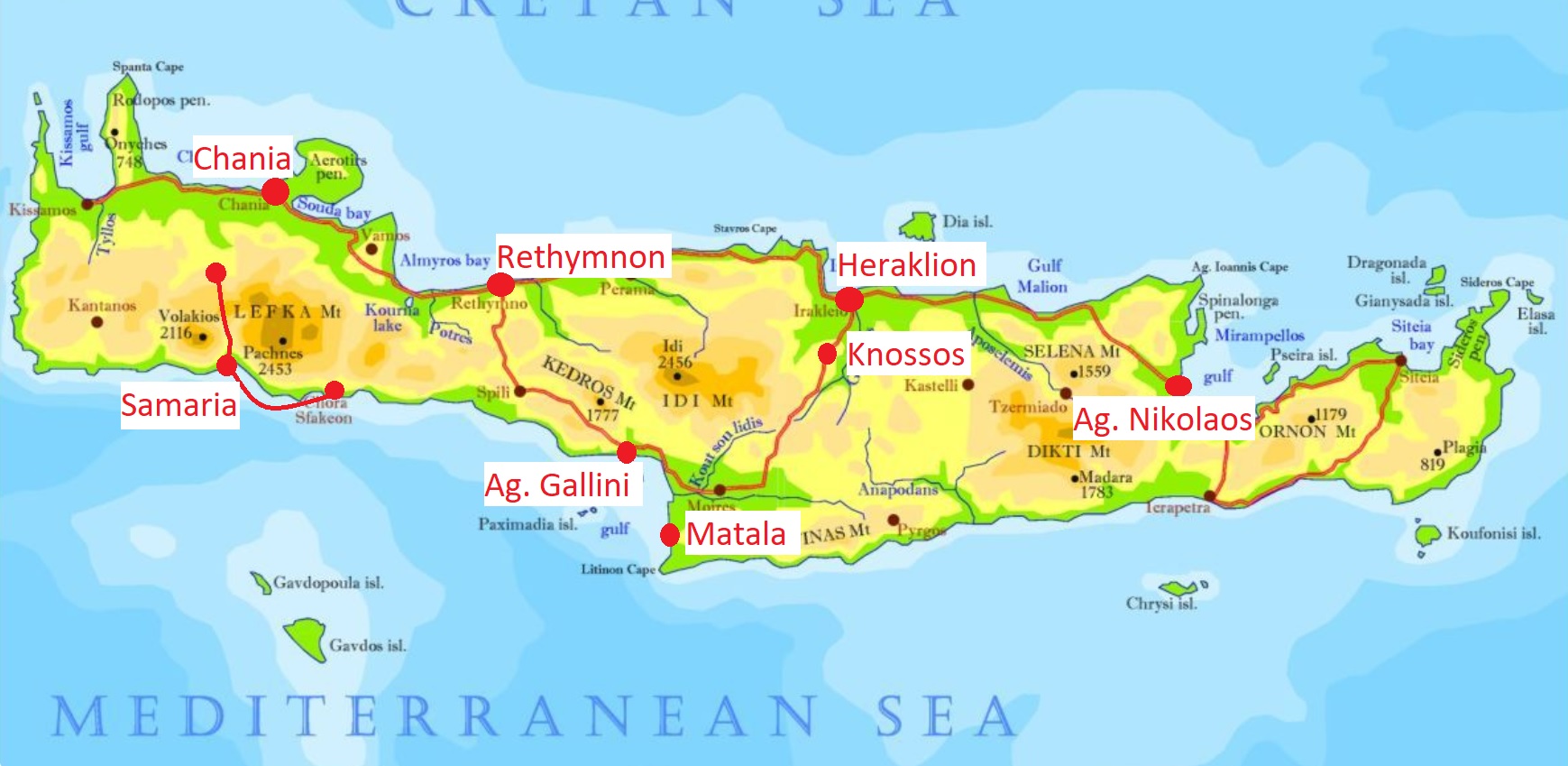
Crete
Crete is the largest and most populous of the Greek islands, the fifth largest island in the Mediterranean Sea, with an area of 8,336 km2. Its capital and largest city is Heraklion.
Humans have inhabited the island since at least 130,000 years ago. Crete was the centre of Europe’s first advanced civilization, the Minoans, from 2700 to 1420 BC. The Minoan civilization was overrun by the Mycenaean civilization from mainland Greece. Crete was later ruled by Rome, then successively by the Byzantine Empire, Andalusian Arabs, the Venetian Republic, and the Ottoman Empire. In 1898 Crete formally became a Cretan State, and became part of Greece in December 1913. The palace of Knossos, a Bronze Age settlement and ancient Minoan city, is also located in Heraklion.
The island is defined by a high mountain range crossing from west to east. It includes Crete’s highest point, Mount Ida, and the range of the White Mountains with 30 summits above 2000 metres, and the Samaria Gorge, a World Biosphere Reserve. Crete forms a significant part of the economy and cultural heritage of Greece, while retaining its own local cultural traits (such as its own poetry and music). The airport at Heraklion and Chania serve international travellers.
I visited Crete in 1979, 1980, 1982 and 2008.
Click on a picture below to start the video:
Rethymnon Evenings, July 2008
Rethymnon is a city of about 40,000 people, originally built during the Minoan civilization. It began a period of growth when the Venetian conquerors of decided to put an intermediate commercial station between Heraklion and Chania, acquiring its own bishop and nobility in the process. Today’s old town was almost entirely built by the Republic of Venice. It is one of the best-preserved old towns in Crete.
he town still maintains its old aristocratic appearance, with its buildings dating from the 16th century, arched doorways, stone staircases, Byzantine and Hellenic-Roman remains, the small Venetian harbour and narrow streets. Other monuments include the Neratze mosque, the Great Gate, the Piazza Rimondi and the Loggia
Rethymnon Fort, July 2008
The city’s Venetian-era citadel, the Fortezza of Rethymno, is one of the best-preserved castles in Crete. The Fortezza is built on a hill called Paleokastro (meaning “Old Castle”), which was the site of ancient Rhithymna’s acropolis. It was built by the Venetians in the 16th century, and was captured by the Ottomans in 1646. By the early 20th century, many houses were built within the citadel. These were demolished after World War II, leaving only a few historic buildings within the Fortezza. Today, the citadel is in good condition and is open to the public.
Parasailing in Rethymnon, July 2008
My daughter joined some friends and had a great time seeing Rethymnon from above while circling the bay in a parachute towed by a speed boat.
Samaria Gorge, July 2008
The Samariá Gorge is a major tourist attraction of and a World’s Biosphere Reserve. It was created by a small river running between the White Mountains and Mt. Volakias. The gorge is 16 km long, starting at an altitude of 1,250 m at the northern entrance, and ending at the shores of the Libyan Sea in Agia Roumeli. The walk through Samaria National Park is 13 km long, but one has to walk another two kilometers to Agia Roumeli from the park exit, making the hike 15 km long. The most famous part of the gorge is the stretch known as the Gates where the sides of the gorge close in to a width of only four meters and soar up to a height of almost 300. To get back to your hotel you can take a boat from Agia Roumeli to Hora Sfakion where you can catch a bus.
